IoT in Smart Cities: Benefits, Challenges, and Literature
VerifiedAdded on 2023/06/04
|5
|1310
|404
Report
AI Summary
This report delves into the application of Internet of Things (IoT) technologies within smart cities, examining both the benefits and challenges associated with their implementation. The literature review highlights the positive impacts of IoT on waste management, air quality monitoring, and energy consumption optimization. The report also includes an annotated bibliography of relevant research papers, focusing on the role of big data and analytics in smart cities, traffic management systems, smart city architecture, and the application of big data. The report covers the benefits and challenges of IoT in smart cities, focusing on waste management, air quality, and energy consumption and how they are being addressed. The report emphasizes the importance of data analysis and integration for the successful development and management of smart city initiatives. It also acknowledges the challenges related to the security and ethical considerations of IoT in smart cities.
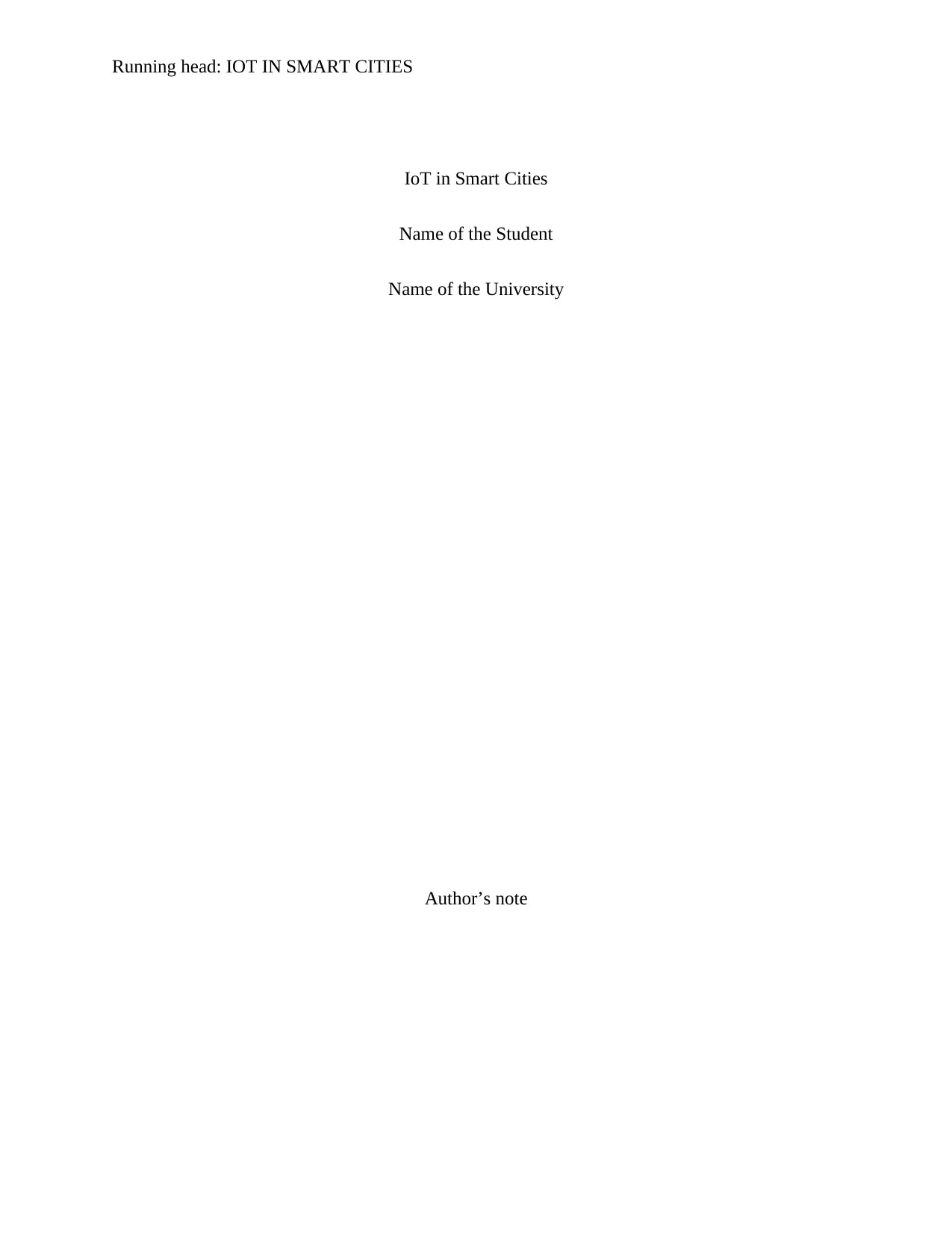
Running head: IOT IN SMART CITIES
IoT in Smart Cities
Name of the Student
Name of the University
Author’s note
IoT in Smart Cities
Name of the Student
Name of the University
Author’s note
Paraphrase This Document
Need a fresh take? Get an instant paraphrase of this document with our AI Paraphraser
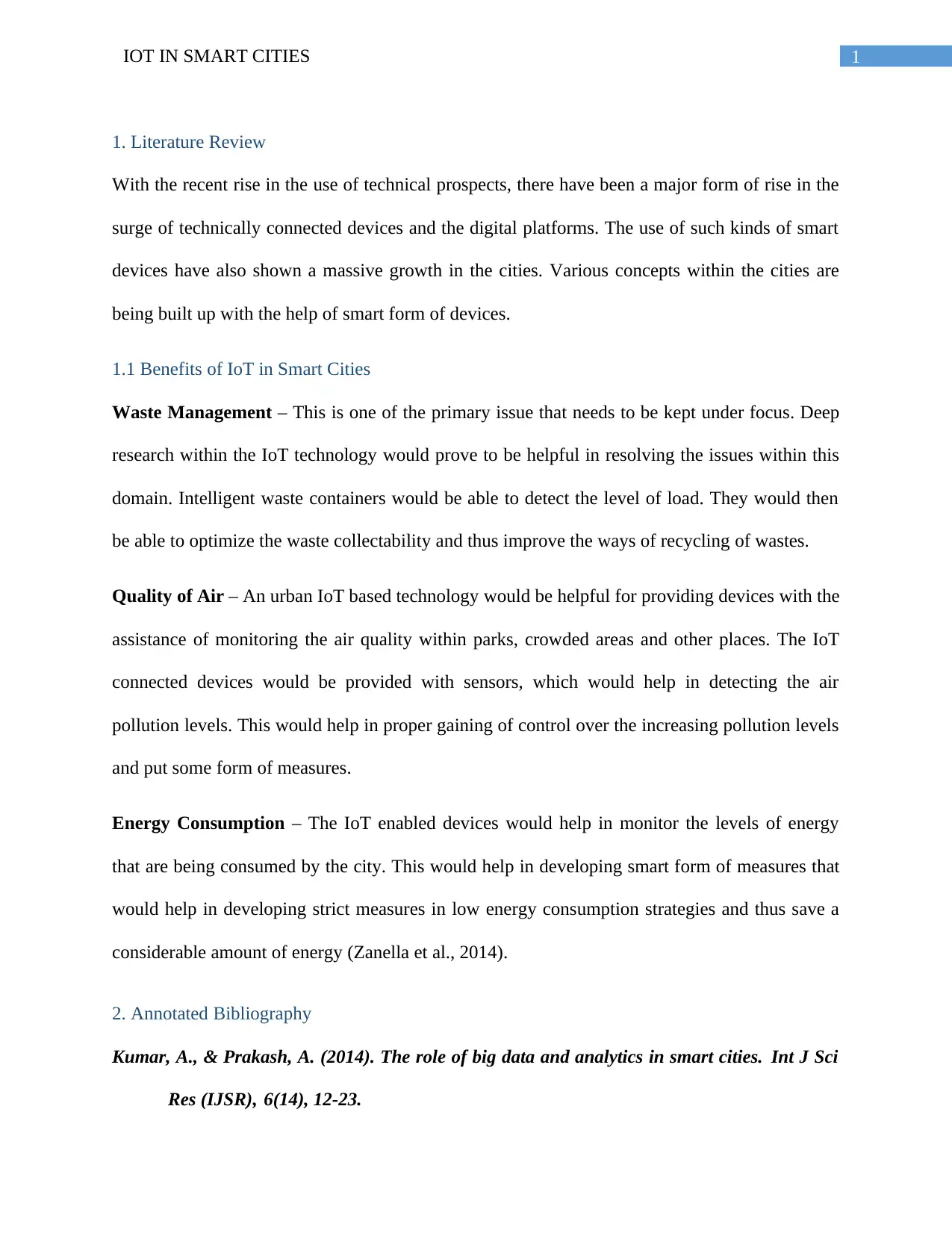
1IOT IN SMART CITIES
1. Literature Review
With the recent rise in the use of technical prospects, there have been a major form of rise in the
surge of technically connected devices and the digital platforms. The use of such kinds of smart
devices have also shown a massive growth in the cities. Various concepts within the cities are
being built up with the help of smart form of devices.
1.1 Benefits of IoT in Smart Cities
Waste Management – This is one of the primary issue that needs to be kept under focus. Deep
research within the IoT technology would prove to be helpful in resolving the issues within this
domain. Intelligent waste containers would be able to detect the level of load. They would then
be able to optimize the waste collectability and thus improve the ways of recycling of wastes.
Quality of Air – An urban IoT based technology would be helpful for providing devices with the
assistance of monitoring the air quality within parks, crowded areas and other places. The IoT
connected devices would be provided with sensors, which would help in detecting the air
pollution levels. This would help in proper gaining of control over the increasing pollution levels
and put some form of measures.
Energy Consumption – The IoT enabled devices would help in monitor the levels of energy
that are being consumed by the city. This would help in developing smart form of measures that
would help in developing strict measures in low energy consumption strategies and thus save a
considerable amount of energy (Zanella et al., 2014).
2. Annotated Bibliography
Kumar, A., & Prakash, A. (2014). The role of big data and analytics in smart cities. Int J Sci
Res (IJSR), 6(14), 12-23.
1. Literature Review
With the recent rise in the use of technical prospects, there have been a major form of rise in the
surge of technically connected devices and the digital platforms. The use of such kinds of smart
devices have also shown a massive growth in the cities. Various concepts within the cities are
being built up with the help of smart form of devices.
1.1 Benefits of IoT in Smart Cities
Waste Management – This is one of the primary issue that needs to be kept under focus. Deep
research within the IoT technology would prove to be helpful in resolving the issues within this
domain. Intelligent waste containers would be able to detect the level of load. They would then
be able to optimize the waste collectability and thus improve the ways of recycling of wastes.
Quality of Air – An urban IoT based technology would be helpful for providing devices with the
assistance of monitoring the air quality within parks, crowded areas and other places. The IoT
connected devices would be provided with sensors, which would help in detecting the air
pollution levels. This would help in proper gaining of control over the increasing pollution levels
and put some form of measures.
Energy Consumption – The IoT enabled devices would help in monitor the levels of energy
that are being consumed by the city. This would help in developing smart form of measures that
would help in developing strict measures in low energy consumption strategies and thus save a
considerable amount of energy (Zanella et al., 2014).
2. Annotated Bibliography
Kumar, A., & Prakash, A. (2014). The role of big data and analytics in smart cities. Int J Sci
Res (IJSR), 6(14), 12-23.
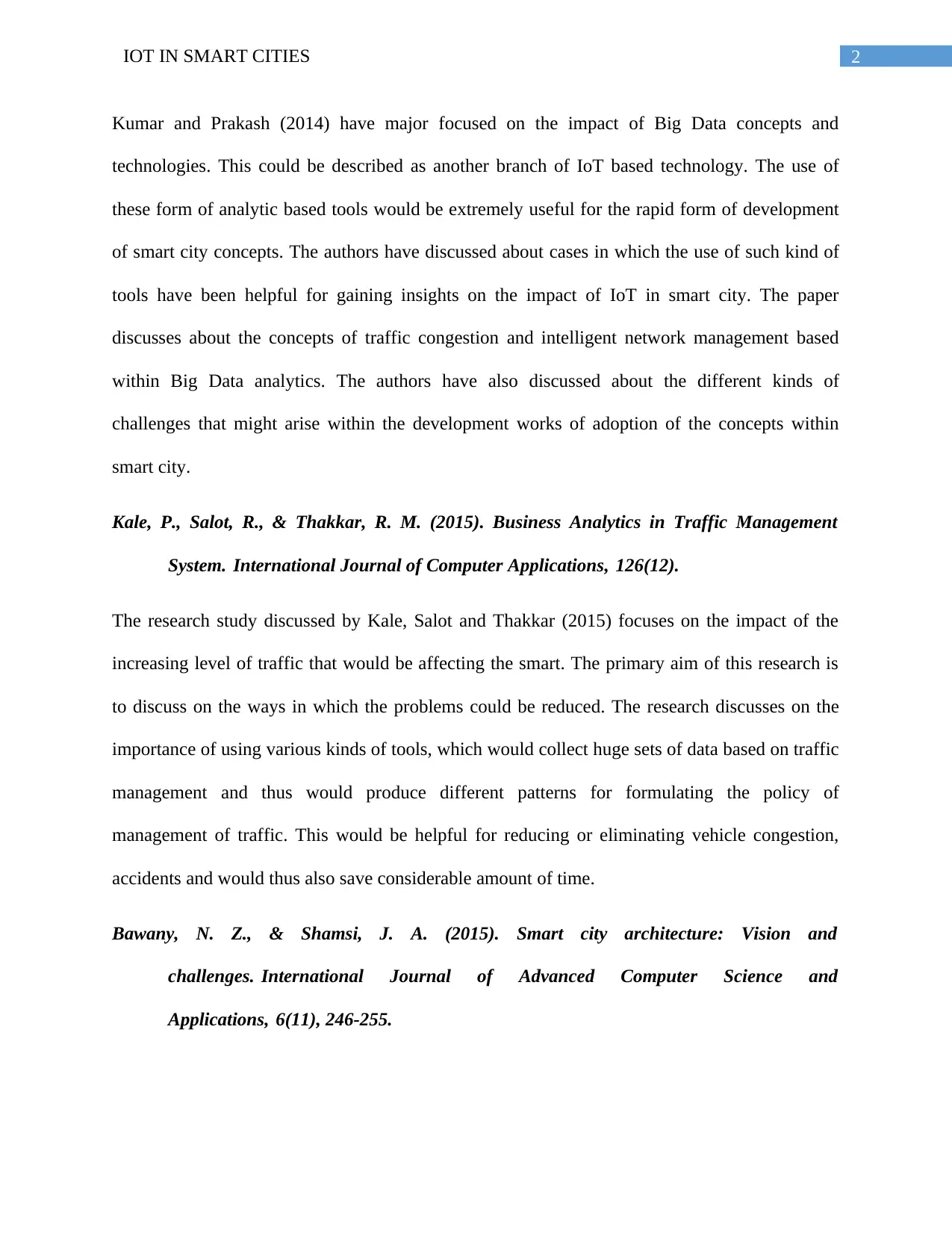
2IOT IN SMART CITIES
Kumar and Prakash (2014) have major focused on the impact of Big Data concepts and
technologies. This could be described as another branch of IoT based technology. The use of
these form of analytic based tools would be extremely useful for the rapid form of development
of smart city concepts. The authors have discussed about cases in which the use of such kind of
tools have been helpful for gaining insights on the impact of IoT in smart city. The paper
discusses about the concepts of traffic congestion and intelligent network management based
within Big Data analytics. The authors have also discussed about the different kinds of
challenges that might arise within the development works of adoption of the concepts within
smart city.
Kale, P., Salot, R., & Thakkar, R. M. (2015). Business Analytics in Traffic Management
System. International Journal of Computer Applications, 126(12).
The research study discussed by Kale, Salot and Thakkar (2015) focuses on the impact of the
increasing level of traffic that would be affecting the smart. The primary aim of this research is
to discuss on the ways in which the problems could be reduced. The research discusses on the
importance of using various kinds of tools, which would collect huge sets of data based on traffic
management and thus would produce different patterns for formulating the policy of
management of traffic. This would be helpful for reducing or eliminating vehicle congestion,
accidents and would thus also save considerable amount of time.
Bawany, N. Z., & Shamsi, J. A. (2015). Smart city architecture: Vision and
challenges. International Journal of Advanced Computer Science and
Applications, 6(11), 246-255.
Kumar and Prakash (2014) have major focused on the impact of Big Data concepts and
technologies. This could be described as another branch of IoT based technology. The use of
these form of analytic based tools would be extremely useful for the rapid form of development
of smart city concepts. The authors have discussed about cases in which the use of such kind of
tools have been helpful for gaining insights on the impact of IoT in smart city. The paper
discusses about the concepts of traffic congestion and intelligent network management based
within Big Data analytics. The authors have also discussed about the different kinds of
challenges that might arise within the development works of adoption of the concepts within
smart city.
Kale, P., Salot, R., & Thakkar, R. M. (2015). Business Analytics in Traffic Management
System. International Journal of Computer Applications, 126(12).
The research study discussed by Kale, Salot and Thakkar (2015) focuses on the impact of the
increasing level of traffic that would be affecting the smart. The primary aim of this research is
to discuss on the ways in which the problems could be reduced. The research discusses on the
importance of using various kinds of tools, which would collect huge sets of data based on traffic
management and thus would produce different patterns for formulating the policy of
management of traffic. This would be helpful for reducing or eliminating vehicle congestion,
accidents and would thus also save considerable amount of time.
Bawany, N. Z., & Shamsi, J. A. (2015). Smart city architecture: Vision and
challenges. International Journal of Advanced Computer Science and
Applications, 6(11), 246-255.
⊘ This is a preview!⊘
Do you want full access?
Subscribe today to unlock all pages.

Trusted by 1+ million students worldwide
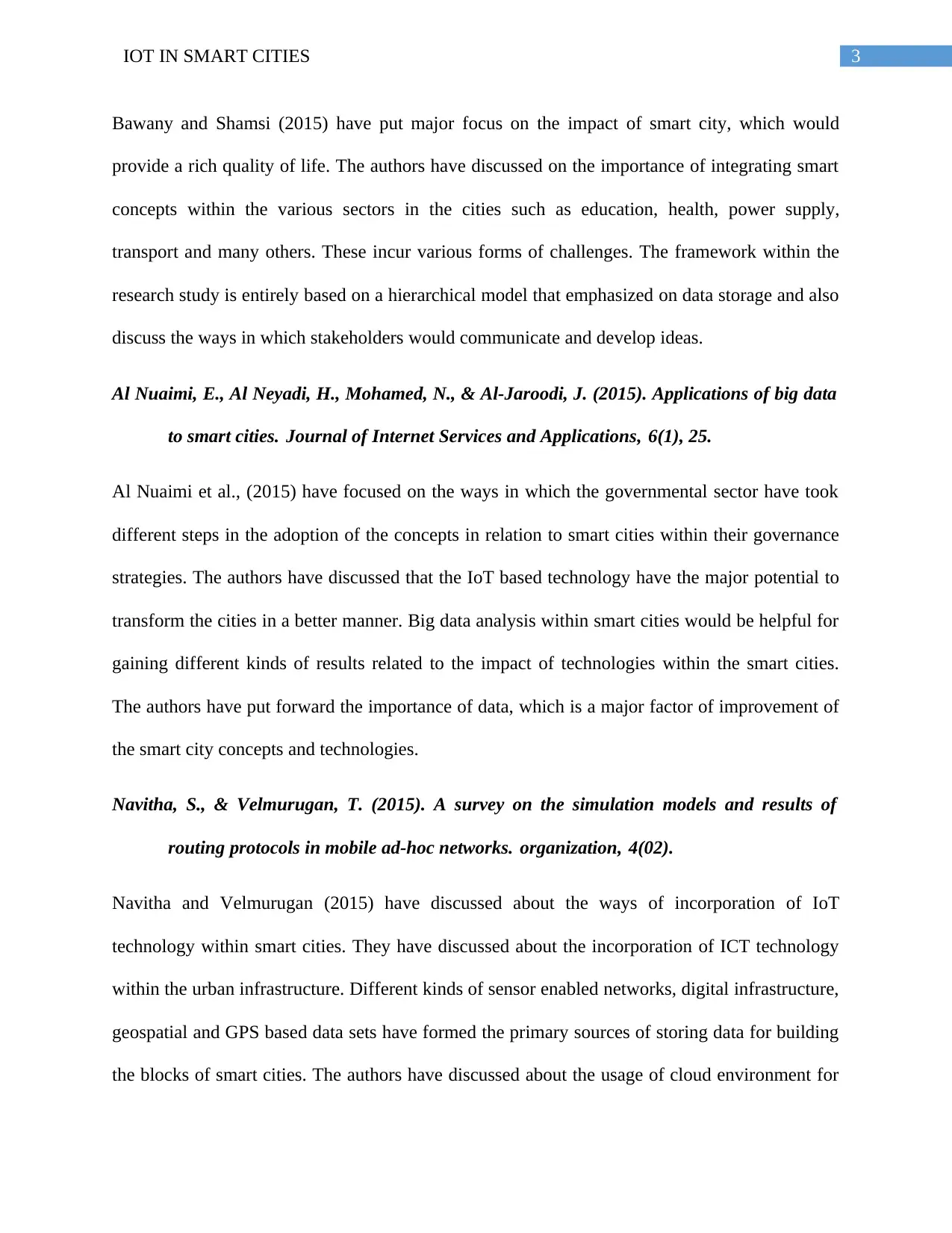
3IOT IN SMART CITIES
Bawany and Shamsi (2015) have put major focus on the impact of smart city, which would
provide a rich quality of life. The authors have discussed on the importance of integrating smart
concepts within the various sectors in the cities such as education, health, power supply,
transport and many others. These incur various forms of challenges. The framework within the
research study is entirely based on a hierarchical model that emphasized on data storage and also
discuss the ways in which stakeholders would communicate and develop ideas.
Al Nuaimi, E., Al Neyadi, H., Mohamed, N., & Al-Jaroodi, J. (2015). Applications of big data
to smart cities. Journal of Internet Services and Applications, 6(1), 25.
Al Nuaimi et al., (2015) have focused on the ways in which the governmental sector have took
different steps in the adoption of the concepts in relation to smart cities within their governance
strategies. The authors have discussed that the IoT based technology have the major potential to
transform the cities in a better manner. Big data analysis within smart cities would be helpful for
gaining different kinds of results related to the impact of technologies within the smart cities.
The authors have put forward the importance of data, which is a major factor of improvement of
the smart city concepts and technologies.
Navitha, S., & Velmurugan, T. (2015). A survey on the simulation models and results of
routing protocols in mobile ad-hoc networks. organization, 4(02).
Navitha and Velmurugan (2015) have discussed about the ways of incorporation of IoT
technology within smart cities. They have discussed about the incorporation of ICT technology
within the urban infrastructure. Different kinds of sensor enabled networks, digital infrastructure,
geospatial and GPS based data sets have formed the primary sources of storing data for building
the blocks of smart cities. The authors have discussed about the usage of cloud environment for
Bawany and Shamsi (2015) have put major focus on the impact of smart city, which would
provide a rich quality of life. The authors have discussed on the importance of integrating smart
concepts within the various sectors in the cities such as education, health, power supply,
transport and many others. These incur various forms of challenges. The framework within the
research study is entirely based on a hierarchical model that emphasized on data storage and also
discuss the ways in which stakeholders would communicate and develop ideas.
Al Nuaimi, E., Al Neyadi, H., Mohamed, N., & Al-Jaroodi, J. (2015). Applications of big data
to smart cities. Journal of Internet Services and Applications, 6(1), 25.
Al Nuaimi et al., (2015) have focused on the ways in which the governmental sector have took
different steps in the adoption of the concepts in relation to smart cities within their governance
strategies. The authors have discussed that the IoT based technology have the major potential to
transform the cities in a better manner. Big data analysis within smart cities would be helpful for
gaining different kinds of results related to the impact of technologies within the smart cities.
The authors have put forward the importance of data, which is a major factor of improvement of
the smart city concepts and technologies.
Navitha, S., & Velmurugan, T. (2015). A survey on the simulation models and results of
routing protocols in mobile ad-hoc networks. organization, 4(02).
Navitha and Velmurugan (2015) have discussed about the ways of incorporation of IoT
technology within smart cities. They have discussed about the incorporation of ICT technology
within the urban infrastructure. Different kinds of sensor enabled networks, digital infrastructure,
geospatial and GPS based data sets have formed the primary sources of storing data for building
the blocks of smart cities. The authors have discussed about the usage of cloud environment for
Paraphrase This Document
Need a fresh take? Get an instant paraphrase of this document with our AI Paraphraser
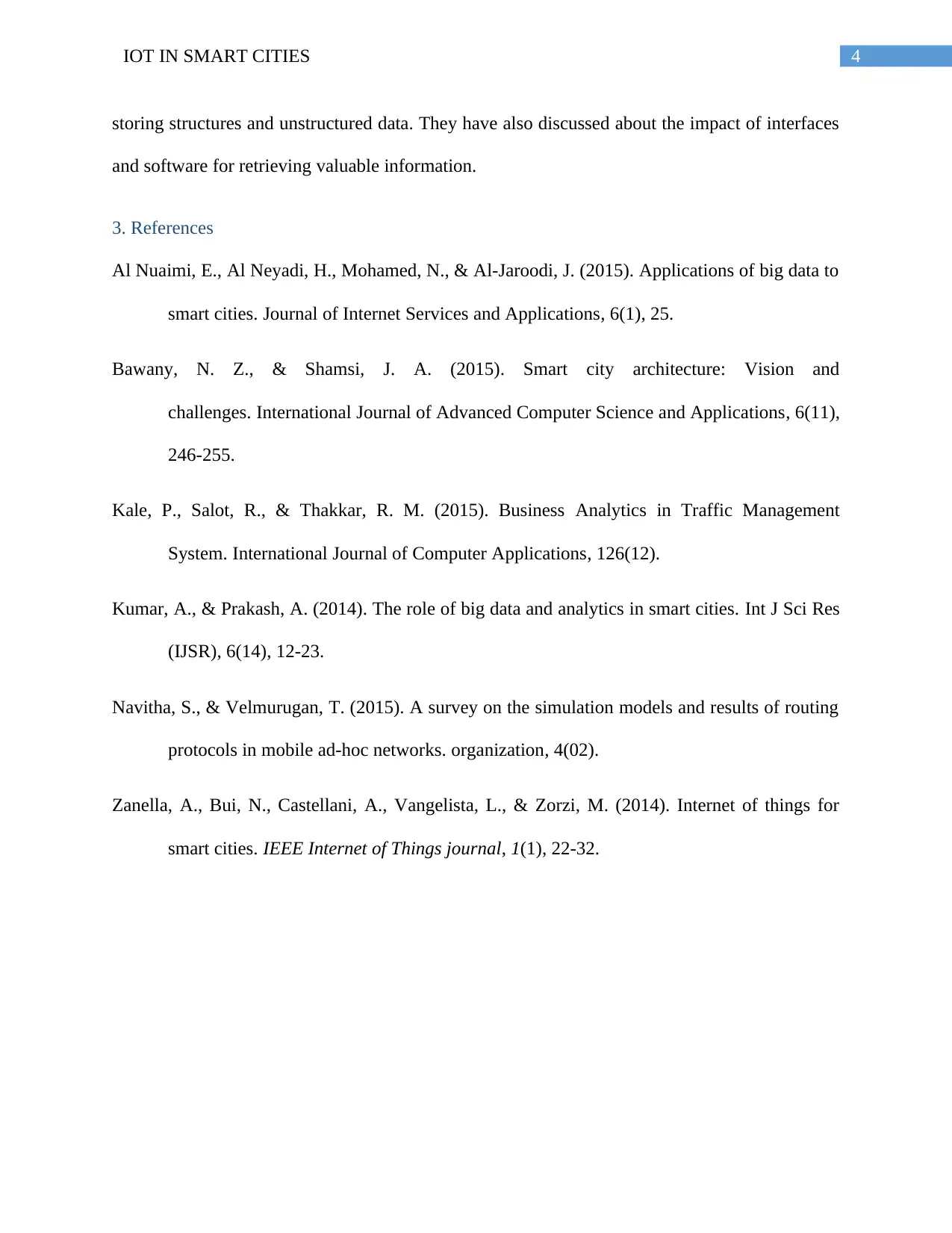
4IOT IN SMART CITIES
storing structures and unstructured data. They have also discussed about the impact of interfaces
and software for retrieving valuable information.
3. References
Al Nuaimi, E., Al Neyadi, H., Mohamed, N., & Al-Jaroodi, J. (2015). Applications of big data to
smart cities. Journal of Internet Services and Applications, 6(1), 25.
Bawany, N. Z., & Shamsi, J. A. (2015). Smart city architecture: Vision and
challenges. International Journal of Advanced Computer Science and Applications, 6(11),
246-255.
Kale, P., Salot, R., & Thakkar, R. M. (2015). Business Analytics in Traffic Management
System. International Journal of Computer Applications, 126(12).
Kumar, A., & Prakash, A. (2014). The role of big data and analytics in smart cities. Int J Sci Res
(IJSR), 6(14), 12-23.
Navitha, S., & Velmurugan, T. (2015). A survey on the simulation models and results of routing
protocols in mobile ad-hoc networks. organization, 4(02).
Zanella, A., Bui, N., Castellani, A., Vangelista, L., & Zorzi, M. (2014). Internet of things for
smart cities. IEEE Internet of Things journal, 1(1), 22-32.
storing structures and unstructured data. They have also discussed about the impact of interfaces
and software for retrieving valuable information.
3. References
Al Nuaimi, E., Al Neyadi, H., Mohamed, N., & Al-Jaroodi, J. (2015). Applications of big data to
smart cities. Journal of Internet Services and Applications, 6(1), 25.
Bawany, N. Z., & Shamsi, J. A. (2015). Smart city architecture: Vision and
challenges. International Journal of Advanced Computer Science and Applications, 6(11),
246-255.
Kale, P., Salot, R., & Thakkar, R. M. (2015). Business Analytics in Traffic Management
System. International Journal of Computer Applications, 126(12).
Kumar, A., & Prakash, A. (2014). The role of big data and analytics in smart cities. Int J Sci Res
(IJSR), 6(14), 12-23.
Navitha, S., & Velmurugan, T. (2015). A survey on the simulation models and results of routing
protocols in mobile ad-hoc networks. organization, 4(02).
Zanella, A., Bui, N., Castellani, A., Vangelista, L., & Zorzi, M. (2014). Internet of things for
smart cities. IEEE Internet of Things journal, 1(1), 22-32.
1 out of 5
Related Documents
Your All-in-One AI-Powered Toolkit for Academic Success.
+13062052269
info@desklib.com
Available 24*7 on WhatsApp / Email
![[object Object]](/_next/static/media/star-bottom.7253800d.svg)
Unlock your academic potential
Copyright © 2020–2025 A2Z Services. All Rights Reserved. Developed and managed by ZUCOL.




